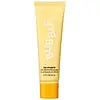What's inside
What's inside
 Key Ingredients
Key Ingredients

 Benefits
Benefits

 Concerns
Concerns

No concerns
 Ingredients Side-by-side
Ingredients Side-by-side

Zinc Oxide 12%
Cosmetic ColorantWater
Skin ConditioningIsoamyl Laurate
EmollientGlycerin
HumectantCaprylic/Capric Triglyceride
MaskingButyloctyl Salicylate
Skin ConditioningPolyglyceryl-10 Stearate
Skin ConditioningPoly C10-30 Alkyl Acrylate
Emulsion StabilisingPolyhydroxystearic Acid
EmulsifyingCetearyl Olivate
Sorbitan Olivate
EmulsifyingRubus Idaeus Seed Oil
EmollientPanax Ginseng Root Extract
EmollientTheobroma Cacao Seed Extract
AntioxidantHydroxyethyl Acrylate/Sodium Acryloyldimethyl Taurate Copolymer
Emulsion StabilisingHydroxyacetophenone
AntioxidantPolyglyceryl-10 Laurate
Skin ConditioningMicrocrystalline Cellulose
AbsorbentButylene Glycol
HumectantXanthan Gum
EmulsifyingCellulose Gum
Emulsion StabilisingPhenoxyethanol
PreservativeZinc Oxide 12%, Water, Isoamyl Laurate, Glycerin, Caprylic/Capric Triglyceride, Butyloctyl Salicylate, Polyglyceryl-10 Stearate, Poly C10-30 Alkyl Acrylate, Polyhydroxystearic Acid, Cetearyl Olivate, Sorbitan Olivate, Rubus Idaeus Seed Oil, Panax Ginseng Root Extract, Theobroma Cacao Seed Extract, Hydroxyethyl Acrylate/Sodium Acryloyldimethyl Taurate Copolymer, Hydroxyacetophenone, Polyglyceryl-10 Laurate, Microcrystalline Cellulose, Butylene Glycol, Xanthan Gum, Cellulose Gum, Phenoxyethanol
Butyl Methoxydibenzoylmethane 3%
UV AbsorberHomosalate 15%
Skin ConditioningEthylhexyl Salicylate 5%
UV AbsorberOctocrylene 7%
UV AbsorberWater
Skin ConditioningSilica
AbrasiveDicaprylyl Carbonate
EmollientStyrene/Acrylates Copolymer
Butyloctyl Salicylate
Skin ConditioningMethyl Methacrylate Crosspolymer
Nylon-12
PEG-100 Stearate
Glyceryl Stearate
EmollientPerlite
AbsorbentBeeswax
Emulsion StabilisingAmmonium Polyacryloyldimethyl Taurate
Emulsion StabilisingPhenoxyethanol
PreservativePEG-8 Laurate
EmulsifyingBehenyl Alcohol
EmollientSodium Stearoyl Glutamate
CleansingChlorphenesin
AntimicrobialP-Anisic Acid
MaskingXanthan Gum
EmulsifyingTocopherol
AntioxidantDisodium EDTA
Arachidyl Alcohol
EmollientDiethylhexyl Syringylidenemalonate
Skin ProtectingPropylene Glycol
HumectantCassia Alata Leaf Extract
AstringentMaltodextrin
AbsorbentStearyl Alcohol
EmollientT-Butyl Alcohol
PerfumingCaprylic/Capric Triglyceride
MaskingButyl Methoxydibenzoylmethane 3%, Homosalate 15%, Ethylhexyl Salicylate 5%, Octocrylene 7%, Water, Silica, Dicaprylyl Carbonate, Styrene/Acrylates Copolymer, Butyloctyl Salicylate, Methyl Methacrylate Crosspolymer, Nylon-12, PEG-100 Stearate, Glyceryl Stearate, Perlite, Beeswax, Ammonium Polyacryloyldimethyl Taurate, Phenoxyethanol, PEG-8 Laurate, Behenyl Alcohol, Sodium Stearoyl Glutamate, Chlorphenesin, P-Anisic Acid, Xanthan Gum, Tocopherol, Disodium EDTA, Arachidyl Alcohol, Diethylhexyl Syringylidenemalonate, Propylene Glycol, Cassia Alata Leaf Extract, Maltodextrin, Stearyl Alcohol, T-Butyl Alcohol, Caprylic/Capric Triglyceride
 Reviews
Reviews

Ingredients Explained
These ingredients are found in both products.
Ingredients higher up in an ingredient list are typically present in a larger amount.
Butyloctyl Salicylate is a chemical UV filter structurally similar to octisalate. It is a photostabilizer, SPF booster, emollient and solvent. This ingredient helps evenly spread out ingredients.
According to a manufacturer, it is suitable for pairing with micro Titanium Dioxide, Zinc Oxide, and pigments.
Photostabilizers help stabilize UV-filters and prevents them from degrading quickly.
Learn more about Butyloctyl SalicylateThis ingredient is an emollient, solvent, and texture enhancer. It is considered a skin-softener by helping the skin prevent moisture loss.
It helps thicken a product's formula and makes it easier to spread by dissolving clumping compounds.
Caprylic Triglyceride is made by combining glycerin with coconut oil, forming a clear liquid.
While there is an assumption Caprylic Triglyceride can clog pores due to it being derived from coconut oil, there is no research supporting this.
Learn more about Caprylic/Capric TriglyceridePhenoxyethanol is a preservative that has germicide, antimicrobial, and aromatic properties. Studies show that phenoxyethanol can prevent microbial growth. By itself, it has a scent that is similar to that of a rose.
It's often used in formulations along with Caprylyl Glycol to preserve the shelf life of products.
Water. It's the most common cosmetic ingredient of all. You'll usually see it at the top of ingredient lists, meaning that it makes up the largest part of the product.
So why is it so popular? Water most often acts as a solvent - this means that it helps dissolve other ingredients into the formulation.
You'll also recognize water as that liquid we all need to stay alive. If you see this, drink a glass of water. Stay hydrated!
Learn more about WaterXanthan gum is used as a stabilizer and thickener within cosmetic products. It helps give products a sticky, thick feeling - preventing them from being too runny.
On the technical side of things, xanthan gum is a polysaccharide - a combination consisting of multiple sugar molecules bonded together.
Xanthan gum is a pretty common and great ingredient. It is a natural, non-toxic, non-irritating ingredient that is also commonly used in food products.
Learn more about Xanthan Gum